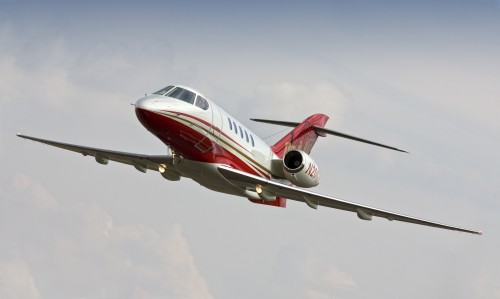


Aircraft Description
Background/History
The SJ-30 is a project of noted aircraft designer Ed Swearingen and was initiated as a concept to produce a low-cost business jet powered by the Williams FJ44 turbofan. The program experienced setbacks with the withdrawal of partners Gulfstream and, subsequently, the Jaffe Group, in 1989 and 1990 respectively. In 1995 Swearingen Aircraft entered into a joint venture with Sino Aerospace Investment Corp. of Taiwan and formed Sino Swearingen, Inc. Based on input received at the 1995 NBAA convention, the decision was made to proceed with development of the stretched -2 variant instead of the original SJ-30. The -2 is powered by the improved FJ44-2 turbofan and benefits from a 1,500 lb. increase in fuel capacity. The SJ-30-2 prototype made its first flight in November 1996. An exemption was approved by the FAA to allow for certification under Part 23 commuter category rules allowing single pilot operations in an aircraft over 12,500 lbs. MTOW. The Emirates Investment & Development Company after becoming majority stockholder in the SinoSwearingen Aircraft Company unveiled the new name, Emivest Aerospace Corporation, in October 2008. Emivest filed bankruptcy in October 2010. SyberJet Aircraft purchased the assets of Emivest Aerospace in early 2011 and moved its assembly line to Cedar City, Utah and continues operations in San Antonio, TX.
Power
The SJ-30-2 is powered by two Williams/Rolls-Royce FJ44-2 turbofans rated at 2,300 lbs. thrust each.
Avionics
The panel of the SJ-30-2 has a combination of mechanical gauges and EFIS displays. The Honeywell Primus 1000 avionics suite is centered on two large CRT’s (one at each pilot position) for attitude and navigation displays, with information fed from dual air data computers and symbol generators. Honeywell radio management systems occupy the center of the panel, flanked on the left side by round-dial engine gauges and on the top by standby flight instruments. A single FMS is optional.
Design Features
The SJ-30-2 is a small, medium-range, twin-turbofan business aircraft configured as a cantilever, swept low-wing monoplane with a swept T-tail and lower tail-section strakes. The tricycle landing gear has dual wheels on each of its trailing-link main units, which retract into the lower-fuselage/wing fairing. The wing employs leading-edge slats, Fowler flaps, and spoilers. The -2 version of the SJ-30 features a significant increase in fuel capacity as a result of the addition of a large aft-fuselage tank. The fuselage has been stretched with an 18-inch plug forward of the wing and a 40-inch plug aft of the wing.
Accomodations
The SJ-30-2 cabin is arranged with a four-seat club, plus a fifth seat in the form of a belted lavatory seat directly across from the cabin door. The two rear club seats are extra wide and unfold to form a berth. Because of the SJ-30’s single pilot exemption under FAA Part 23, the copilot’s position can be used to seat a sixth passenger.
| General | SJ-30-2 | |||
|---|---|---|---|---|
| Category | Jet < 20,000 lbs. | |||
| Years Aircraft Manufactured | 2007 – current | |||
| Serial Number Range | 001 – up | |||
| Retail High Price | $7,250,000.00 / 5,689,075.00€ | |||
| Retail Low Price | $5,495,855.00 / 4,312,597.41€ | |||
| Characteristics | SJ-30-2 | |||
| Seating | 1 + 5/6 | |||
| Wing Loading | 73.2 | |||
| Power Loading | 3.0 | |||
| Noise(EPNdB): Takeoff/Sideline/Approach | 78.5/86.2/91.8 | |||
| External Dimensions (ft) | SJ-30-2 | |||
| External Length | 46.8 | |||
| External Height | 14.2 | |||
| External Span | 42.3 | |||
| Internal Dimensions (ft) | SJ-30-2 | |||
| Internal Length (Overall/Net Height) | 12.5/12.5 | |||
| Internal Height | 4.4 | |||
| Internal Width (Max/Floor) | 4.8/2.8 | |||
| Baggage | SJ-30-2 | |||
| External: Cu.Ft./Lb. | 6/100 | |||
| External: Cu.Ft./Lb. | 53/500 | |||
| Power | SJ-30-2 | |||
| Engines | 2 Wms/RR FJ44-2A | |||
| Output (lbs ea.)/Flat Rating | 2,300/ISA+8C | |||
| Inspection Interval | 3500t | |||
| Data based on latest manufactured year | ||||



